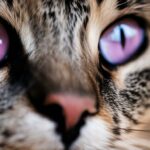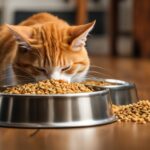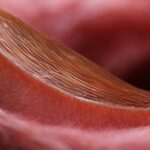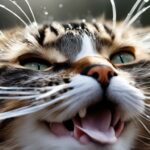As a cat owner, you may have wondered if cats can have deviated septums. It’s a valid question, considering how common this condition is in humans. In this article, I will explain the possibility of cats having deviated septums and the implications it may have on their health.
Key Takeaways:
- Cats can indeed have deviated septums, just like humans.
- A deviated septum in cats can lead to various health issues and nasal congestion.
- Diagnosis of a deviated septum in cats requires thorough examination and imaging techniques.
- Surgical treatment may be necessary to alleviate symptoms and improve the cat’s quality of life.
- Regular veterinary check-ups and early intervention are essential for managing feline deviated septums.
Understanding Nasal Polyps in Cats
Nasal polyps are benign fleshy growths that can develop in the nasal passages of cats. These growths can cause a range of symptoms, including sneezing, increased respiratory sounds, nasal congestion, and nasal discharge. In some cases, nasal polyps may extend from the nasal passages into the throat, leading to more severe symptoms such as difficulty breathing and swallowing.
Diagnosing nasal polyps in cats involves a careful examination, imaging techniques like radiographs or CT scans, and specialized tools like rhinoscopy. Rhinoscopy allows veterinarians to directly visualize the nasal cavity and collect samples for further analysis.
Treatment options for nasal polyps in cats often involve surgical removal of the growths. This can be done under general anesthesia, either by traction or avulsion. In some cases, laser ablation or ventral bulla osteotomy may be necessary. Medications may also be prescribed to reduce inflammation and prevent recurrence.
Symptoms of Nasal Polyps in Cats:
- Sneezing
- Increased respiratory sounds
- Nasal congestion
- Nasal discharge
- Difficulty breathing and swallowing (in more severe cases)
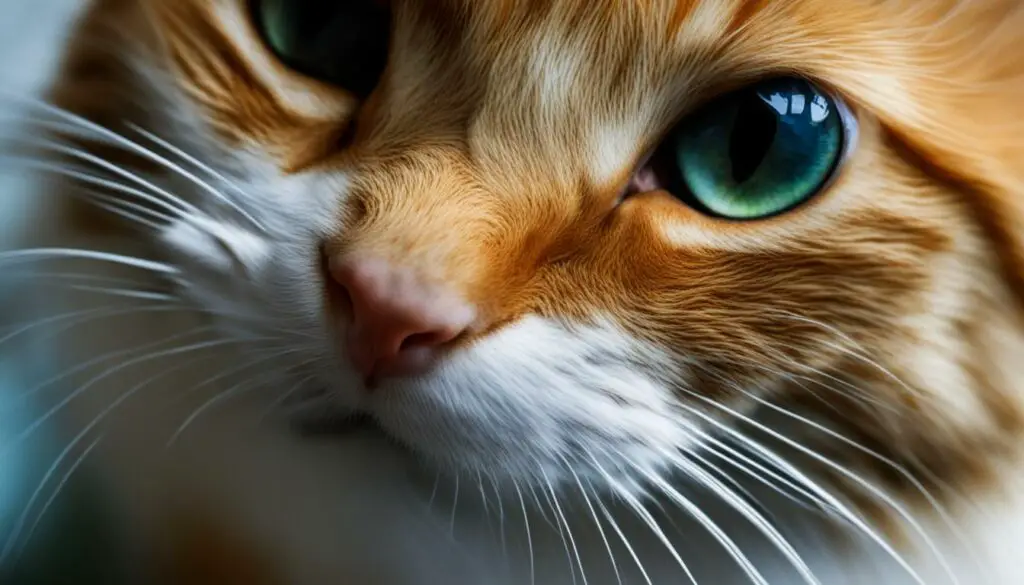
| Treatment Options | Pros | Cons |
|---|---|---|
| Surgical removal | – Provides immediate relief – Can improve overall health – May prevent recurrence (but not guaranteed) |
– Requires general anesthesia – Potential for complications – Moderate likelihood of recurrence |
| Medication | – Reduces inflammation – Prevents recurrence (in some cases) – Non-invasive |
– May not provide complete resolution – Requires long-term use |
Causes of Nasal Polyps in Cats
Nasal polyps in cats can be caused by various factors, though the exact cause is not fully understood. A genetic predisposition is suspected, meaning that certain cats may be more prone to developing nasal polyps than others. Additionally, infections can play a role in triggering inflammation and the formation of these fleshy growths in the nasal passages.
While nasal polyps can occur in cats of any breed, they are most commonly observed in young cats. This suggests that age may also be a contributing factor to their development. However, further research is needed to fully understand the underlying causes of nasal polyps in cats.
Possible Causes of Nasal Polyps in Cats:
- Genetic predisposition
- Infections
- Age
- Other factors yet to be determined
“The exact cause of nasal polyps in cats is not fully understood, but a genetic predisposition is suspected. Certain infections may also play a role in triggering inflammation and the development of nasal polyps. While nasal polyps can occur in cats of any breed, they are most commonly observed in young cats.”
Understanding the causes of nasal polyps in cats is crucial for their diagnosis, treatment, and prevention. By identifying the underlying factors contributing to their development, veterinarians can better tailor their approach to managing this feline health condition.
| Causes of Nasal Polyps in Cats |
|---|
| Genetic predisposition |
| Infections |
| Age |
| Other factors yet to be determined |
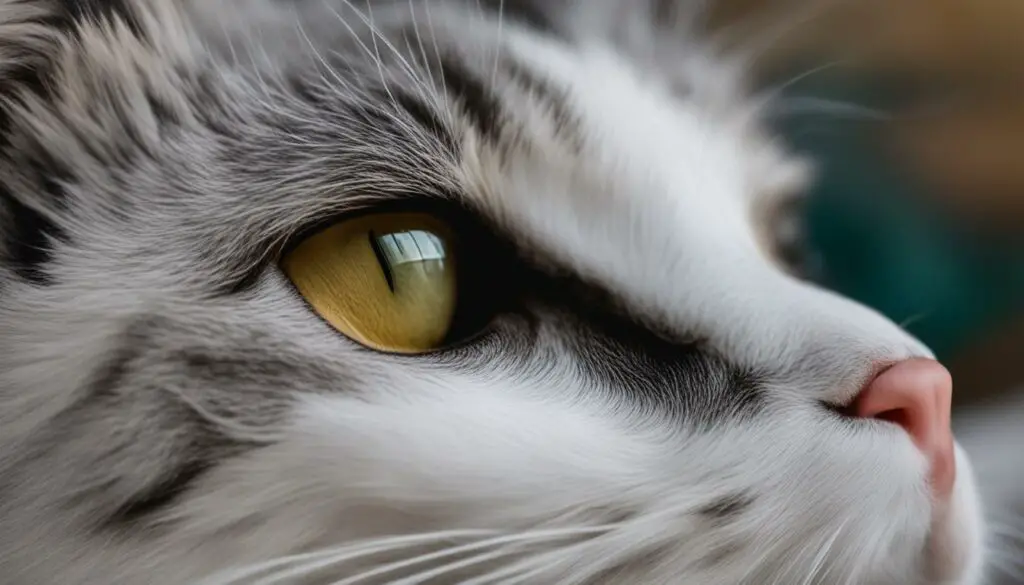
In conclusion, while the exact causes of nasal polyps in cats are not fully understood, a genetic predisposition and infections are believed to play a role. Young cats are most commonly affected by this condition. Further research is needed to gain a comprehensive understanding of the development of nasal polyps in cats.
Diagnosing Nasal Polyps in Cats
Diagnosing nasal polyps in cats involves a thorough examination and the use of specialized tools and imaging techniques. During a physical examination, the veterinarian may be able to observe the presence of nasal polyps. However, in some cases, further diagnostic procedures are necessary to confirm the diagnosis and assess the extent of the polyps.
Rhinoscopy is a valuable tool in the diagnosis of nasal polyps. It allows for direct visualization of the nasal cavity using fiberoptic bronchoscopes or rigid endoscopes. This technique not only helps identify the presence of polyps but also allows for targeted tissue sampling through biopsy. Biopsy is essential for obtaining a definitive diagnosis and ruling out other possible causes of nasal symptoms.
In addition to rhinoscopy, imaging techniques such as radiography, CT scans, or MRI may be used to assess the extent of the disease and identify any underlying structural abnormalities. These imaging modalities provide detailed information about the nasal passages and surrounding structures, aiding in the diagnosis and treatment planning.
Table: Diagnostic Approaches for Nasal Polyps in Cats
| Diagnostic Approach | Description |
|---|---|
| Physical examination | Initial assessment of nasal polyps |
| Rhinoscopy | Direct visualization of nasal cavity and biopsy |
| Imaging (radiography, CT scans, MRI) | Assessment of extent and structural abnormalities |
| Biopsy | Definitive diagnosis through histopathology |
Overall, a comprehensive diagnostic approach, including physical examination, rhinoscopy, and imaging, is crucial for accurately diagnosing nasal polyps in cats. This allows veterinarians to determine the best course of treatment and provide appropriate care to improve the cat’s quality of life.
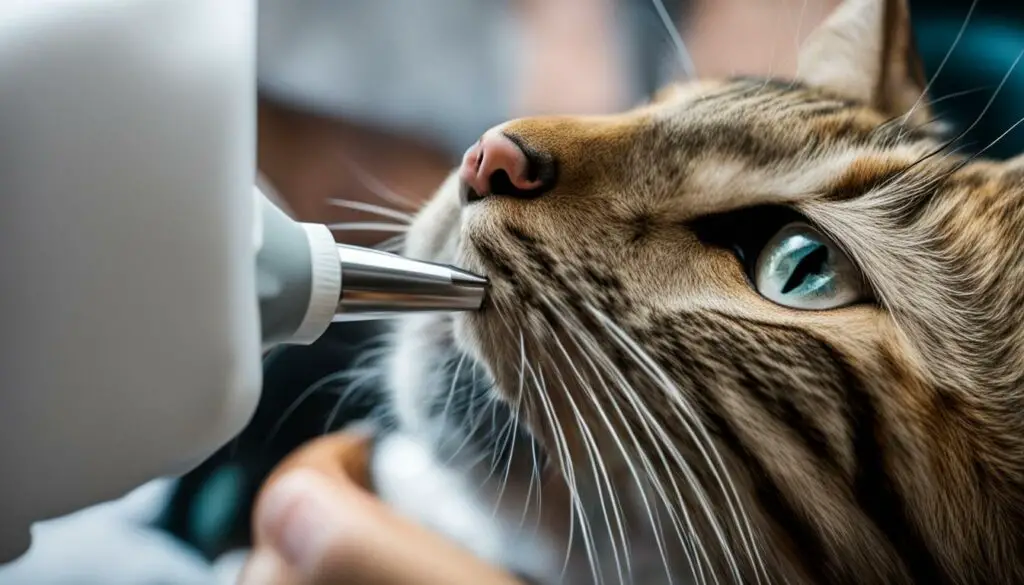
Treatment for Nasal Polyps in Cats
When it comes to treating nasal polyps in cats, surgical removal is a common approach. Under general anesthesia, the polyps can be pulled or torn away using traction or avulsion techniques. In more complex cases, laser ablation or ventral bulla osteotomy may be necessary. After the polyps are removed, antibiotics may be prescribed to prevent infection, and steroids may be used to reduce inflammation and the chances of polyp recurrence.
It’s important to note that while surgical removal can provide relief and improve a cat’s health, the likelihood of polyp recurrence can vary. Some cats may require ongoing medical management to prevent the polyps from coming back. Regular check-ups with a veterinarian are crucial to monitor the cat’s condition and make necessary adjustments to the treatment plan.
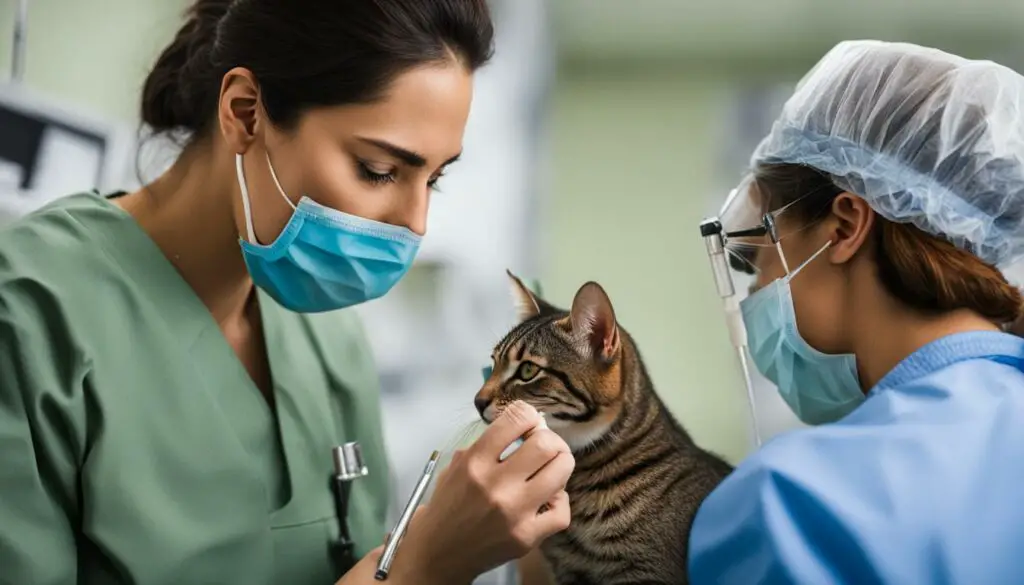
As with any surgical procedure, there are potential risks and complications associated with the treatment of nasal polyps in cats. However, these risks can be minimized with careful preoperative evaluation and planning. The prognosis for cats with nose diseases, including nasal polyps, depends on various factors such as the extent of the disease and the success of the treatment. Working closely with a veterinarian and following their recommendations can help ensure the best possible outcome for cats with nasal polyps.
Recurrence and Prognosis of Nasal Polyps in Cats
Nasal polyps in cats can have a moderate likelihood of recurrence, with rates ranging from 15% to 50% after surgical removal. The factors that contribute to polyp development and recurrence are not fully understood, making prevention challenging. If nasal polyps do recur, further surgical removal may be necessary to alleviate symptoms and improve the cat’s quality of life.
The prognosis for cats with nasal polyps depends on various factors, including the extent of the disease and the response to treatment. Early detection and intervention are crucial in managing nasal polyps effectively. Cats that receive timely surgical removal of polyps and appropriate medical management have a better prognosis than those with advanced or recurring polyps.
Regular check-ups and monitoring are essential for cats with a history of nasal polyps. Veterinarians can evaluate the nasal passages for any signs of recurrence during routine examinations. If recurrence is detected, further diagnostic tests may be recommended to assess the extent of the disease and determine the most appropriate treatment plan.
| Factors Affecting Recurrence | Prognosis |
|---|---|
| Extent and size of the polyps | Early detection and intervention improve the prognosis |
| Genetic predisposition | Close monitoring and regular check-ups are crucial to prevent recurrence |
| Response to treatment | Appropriate medical management can help minimize the likelihood of recurrence |
While nasal polyps can present challenges due to their potential for recurrence, with proper veterinary care and management, cats can continue to lead happy and healthy lives. Regular communication and collaboration with a veterinarian are essential in ensuring the best possible outcome for cats with nasal polyps.

Overview of Feline Nose Diseases
Feline nose diseases are common conditions that can affect cats, causing a range of symptoms and discomfort. These diseases include neoplasia, rhinitis (inflammation of the nasal lining), foreign bodies, fungal infections, and nasal polyps. Recognizing the signs of these diseases is essential for prompt diagnosis and appropriate treatment.
Cats with nose diseases may experience symptoms such as sneezing, nasal discharge, facial swelling, and difficulty breathing. These signs can be similar to those of upper respiratory infections, making it important to differentiate between the various conditions. Proper diagnosis involves a combination of history-taking, clinical examination, and diagnostic tools, such as imaging and cytology.
Treatment options for feline nose diseases depend on the specific condition and its severity. Surgical techniques, such as biopsies, rhinotomy (surgical opening of the nasal cavity), or nasal planectomy (removal of the nasal planum), may be performed to address the underlying issue. Careful planning and follow-up care are necessary to minimize complications and ensure a positive outcome. It’s important for cat owners to work closely with their veterinarian to develop a treatment plan tailored to their cat’s individual needs.
| Common Feline Nose Diseases | Symptoms | Treatment |
|---|---|---|
| Neoplasia | Sneezing, nasal discharge, facial swelling, difficulty breathing | Surgical removal of tumors, radiation therapy, chemotherapy |
| Rhinitis | Sneezing, nasal discharge, congestion, facial discomfort | Antibiotics, antiviral medications, nasal decongestants, supportive care |
| Foreign Bodies | Sneezing, nasal discharge, pawing at the face, nasal bleeding | Surgical removal of the foreign object, supportive care |
| Fungal Infections | Sneezing, nasal discharge, nasal bleeding, facial swelling | Antifungal medications, supportive care |
| Nasal Polyps | Sneezing, increased respiratory sounds, nasal congestion, nasal discharge | Surgical removal of the polyps, medications to reduce inflammation |
It’s important for cat owners to be aware of the possibility of feline nose diseases and seek veterinary care if they notice any concerning symptoms. Early diagnosis and treatment can improve the cat’s quality of life and prevent the progression of the condition. With proper care and attention, cats with nose diseases can lead happy and healthy lives.
Symptoms and Diagnosis of Feline Nose Diseases
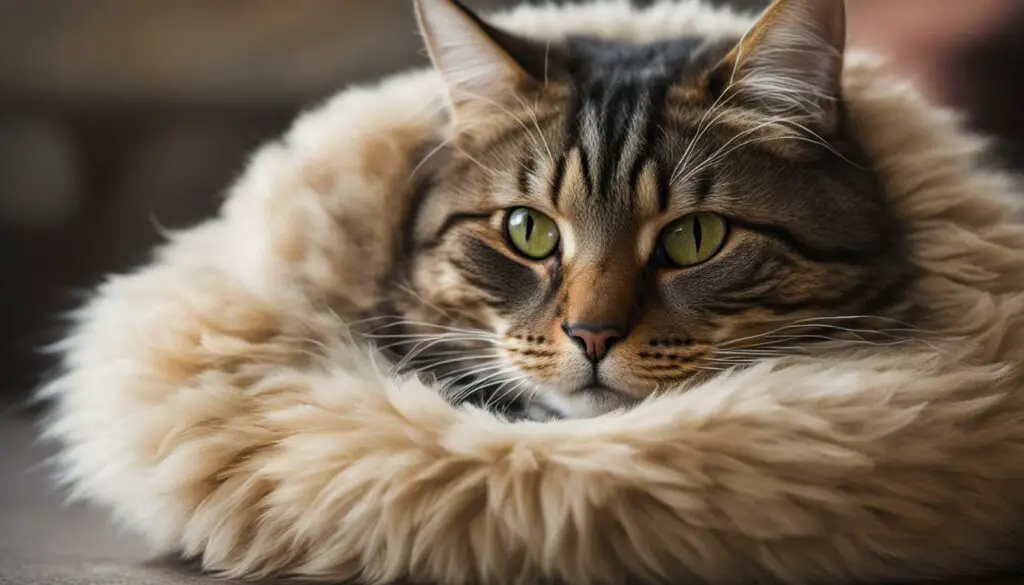
When it comes to feline nose diseases, it is important to be aware of the various symptoms and diagnostic approaches. Recognizing the signs of cat nasal problems can help owners seek timely veterinary care and ensure proper diagnosis. Common symptoms of feline nose diseases include sneezing, nasal discharge, abnormal breathing sounds (such as stertor), excessive tearing (epiphora), and difficulty breathing.
Nasal deformity in cats can also present with facial swelling or distortion. However, it is important to note that these symptoms can be similar to those of upper respiratory infections, making diagnosis challenging. To accurately diagnose feline deviated septum and other nose diseases, veterinarians may use a combination of history-taking, clinical examinations, imaging techniques (such as radiography and CT scans), and cytology or histology of nasal samples.
Diagnostic Approaches
The diagnostic approaches for feline nose diseases involve a step-by-step process to gather information and reach a definitive diagnosis. Radiography is a commonly used technique that provides initial information about the nasal cavity and surrounding structures. Rhinoscopy, on the other hand, allows direct visualization of the nasal cavity using specialized tools like fiberoptic bronchoscopes and rigid endoscopes. This technique also enables targeted tissue sampling through biopsy, which is crucial for obtaining a definitive diagnosis.
In addition to imaging and rhinoscopy, cytology and histology play important roles in diagnosing feline nose diseases. Cytology involves the analysis of nasal samples to identify abnormal cell types and provide preliminary diagnoses. However, for a definitive diagnosis, histopathological examination of biopsy samples is often necessary. These comprehensive diagnostic approaches help veterinarians accurately identify the underlying cause of nasal deformity and other feline nose diseases.
By recognizing the symptoms of cat nasal problems and understanding the diagnostic approaches, cat owners can work closely with their veterinarians to ensure prompt diagnosis and appropriate treatment for their furry companions.
Diagnostic Approaches for Feline Nose Diseases
When it comes to diagnosing feline nose diseases, a comprehensive approach is necessary to obtain accurate results. This involves a combination of history-taking, clinical examination, imaging, and cytology or histology of nasal samples.
During the history-taking process, the veterinarian will gather information about the cat’s symptoms, medical history, and any potential exposure to infectious agents or allergens. This information can provide valuable insights into the underlying cause of the nose disease.
Clinical examination involves a thorough physical examination of the cat, with a focus on the nasal passages. The veterinarian will assess the presence of any abnormalities, such as masses, deformities, or foreign bodies. Nasal airflow can be evaluated by observing condensation on glass or feeling airflow through the nostrils.
Imaging techniques, including radiography, CT scans, or MRI, are often utilized to visualize the nasal cavity and surrounding structures. These imaging modalities can help identify the presence of polyps, tumors, or other abnormalities. In some cases, contrast agents may be used to enhance the visibility of certain structures.
Table: Diagnostic Approaches for Feline Nose Diseases
| Approach | Description |
|---|---|
| History-taking | Gathering information about symptoms, medical history, and potential exposure |
| Clinical examination | Thorough physical examination of the cat’s nasal passages |
| Imaging | Radiography, CT scans, or MRI to visualize the nasal cavity and surrounding structures |
| Cytology and histology | Collection of nasal samples for cytology or histopathology to analyze cellular and tissue changes |
Cytology and histology are essential diagnostic tools in feline nose diseases. Cytology involves collecting nasal samples and analyzing them under a microscope to identify abnormal cellular changes. This technique can provide valuable insights into the underlying cause of the disease. Histology, on the other hand, involves the examination of tissue samples obtained through biopsy. This more invasive procedure allows for a detailed assessment of tissue structure and can provide a definitive diagnosis in many cases.
By employing these diagnostic approaches, veterinarians can accurately identify the cause of feline nose diseases and develop an appropriate treatment plan tailored to the individual cat’s needs.
Imaging for Feline Nose Diseases
When it comes to diagnosing and treating feline nose diseases, imaging techniques play a crucial role in providing valuable insights into the condition. Radiography, CT scans, and MRI are commonly utilized to visualize the nasal cavity and surrounding structures, helping veterinarians make accurate diagnoses and develop effective treatment plans.
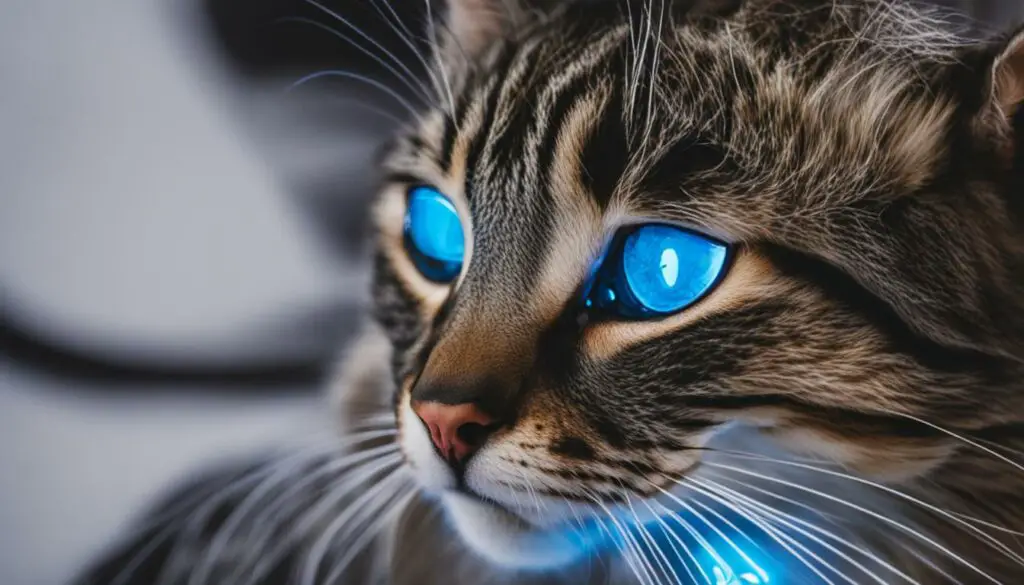
Radiography
Radiography, also known as X-ray imaging, is a commonly used modality in veterinary medicine. It involves taking X-ray images of the cat’s head and nasal area to assess the nasal passages and detect any abnormalities. Radiographs are particularly useful for evaluating bony structures, identifying foreign bodies, and assessing the extent and location of nasal polyps or other masses.
CT Scans
CT scans, or computed tomography scans, provide more detailed and three-dimensional images of the nasal cavity and surrounding structures. This imaging modality uses X-rays and advanced computer algorithms to create cross-sectional images that offer enhanced visualization of soft tissues, such as the nasal mucosa and polyps. CT scans are especially valuable for evaluating the extent and severity of nasal diseases, aiding in surgical planning, and guiding targeted interventions.
MRI
MRI, or magnetic resonance imaging, is another powerful imaging technique commonly used in veterinary medicine. It utilizes a powerful magnetic field and radio waves to generate detailed images of the cat’s nasal structures. MRI is particularly useful for assessing soft tissue abnormalities, such as tumors or inflammation, and can provide valuable information about the involvement of adjacent structures.
In conclusion, imaging techniques, including radiography, CT scans, and MRI, are essential tools for diagnosing and managing feline nose diseases. These modalities enable veterinarians to visualize the nasal cavity and surrounding structures, providing valuable information about the extent and nature of the disease. By utilizing the insights gained from imaging, veterinarians can develop comprehensive treatment plans that optimize the health and well-being of cats with nasal issues.
Rhinoscopy for Feline Nose Diseases
When it comes to diagnosing and treating feline nose diseases, rhinoscopy is an invaluable tool. This procedure involves the direct visualization of the nasal cavity using specialized tools like fiberoptic bronchoscopes and rigid endoscopes. By inserting these instruments into the nostrils, veterinarians can examine the nasal passages and identify any masses, foreign bodies, or abnormalities that may be present.
Rhinoscopy also allows for targeted tissue sampling through biopsy, which can be crucial for obtaining a definitive diagnosis. By collecting samples from suspicious areas, veterinarians can send them for histopathological examination to determine the nature of the condition. This is especially important in cases of rapid clinical progression or when the initial diagnosis is uncertain.
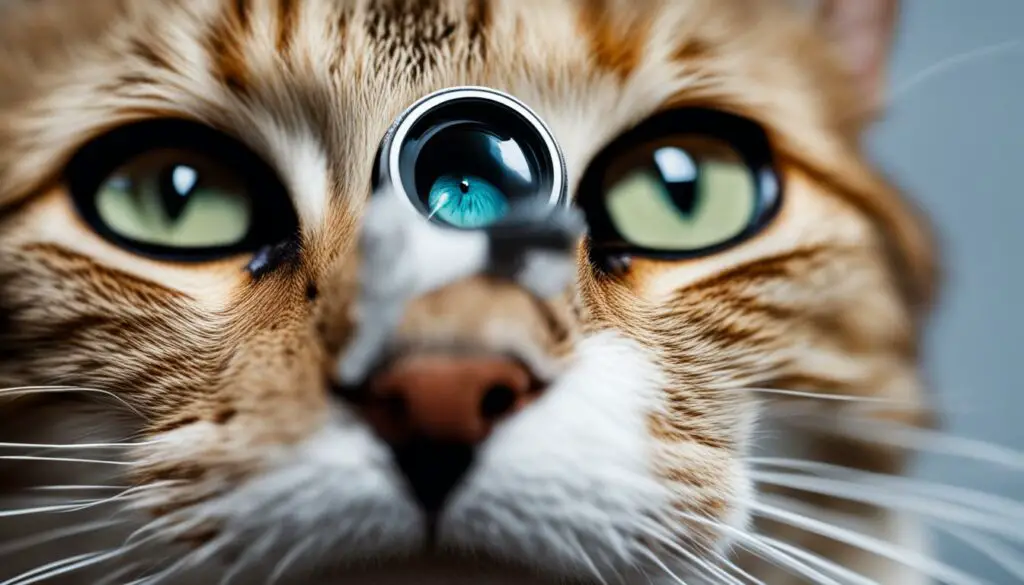
Rhinoscopy Procedure
The rhinoscopy procedure typically involves the use of a local anesthetic to numb the nasal cavity and minimize discomfort for the cat. The fiberoptic or rigid endoscope is then carefully inserted into one nostril and advanced through the nasal passages while a real-time video feed is displayed on a screen.
“Rhinoscopy allows for targeted tissue sampling through biopsy, crucial for obtaining a definitive diagnosis.”
During the procedure, the veterinarian can visualize the nasal turbinates, septum, and other structures to identify any abnormalities. If necessary, they can use specialized instruments to collect biopsy samples for further examination. The samples are then sent to a laboratory for histopathological analysis to determine the presence of inflammation, infections, or neoplastic diseases.
In conclusion, rhinoscopy is an essential tool in the diagnosis of feline nose diseases. It enables veterinarians to directly visualize and evaluate the nasal cavity, identify abnormalities, and collect biopsy samples for further analysis. With the information obtained through rhinoscopy, veterinarians can provide accurate diagnoses and develop appropriate treatment plans for cats with nose problems.
Importance of Cytology, Histology, and Culture in Feline Nose Diseases
When diagnosing feline nose diseases, various diagnostic techniques play a crucial role in obtaining accurate and definitive results. Cytology, histology, and culture are particularly important in understanding and managing these conditions.
Cytology for Feline Deviated Septum
Cytology involves the microscopic examination of cells obtained from nasal samples. It can provide valuable insights into the underlying pathology of feline nose diseases. Squash techniques are commonly used to prepare samples for analysis, offering relatively accurate results. However, brush sampling may be less reliable. Cytologic analysis can help identify the presence of inflammation, infectious agents, or neoplastic cells, aiding in the diagnosis and treatment of feline deviated septum.
Histology for Cat Nasal Issues
Histopathological examination of nasal tissue samples is often necessary for a definitive diagnosis of cat nasal issues. This involves the detailed microscopic examination of the tissue to identify any cellular abnormalities or structural changes. Histology helps differentiate between various nasal diseases and can provide valuable insights into their aggressiveness and potential for recurrence. Obtaining tissue samples through biopsy is essential in cases of rapid clinical progression or when cytologic analysis is inconclusive.
Culture in Feline Nose Diseases
Culture is a diagnostic technique that involves growing microorganisms from nasal samples to identify their presence and guide specific treatment. In cases of suspected fungal infections, cultures can help identify the specific type of fungus and determine the most effective antifungal medications. Bacterial cultures may also be performed to guide antibiotic therapy in cases of nasal infections. The results of the culture can inform targeted treatment approaches, improving the prognosis for cats with feline nose diseases.
By utilizing cytology, histology, and culture, veterinarians can gain a comprehensive understanding of feline nose diseases and develop tailored treatment plans. These diagnostic techniques help ensure accurate diagnoses, guide appropriate therapies, and enhance the overall management of nasal issues in cats.

Surgical Techniques for Feline Nose Diseases
When it comes to treating feline nose diseases, surgical techniques can play a crucial role in providing relief and improving the overall health of cats. Depending on the specific condition and its extent, different surgical approaches may be used to address the underlying issues.
One common surgical technique involves performing biopsies, which help obtain tissue samples for further examination. This can be especially important in cases where a definitive diagnosis is needed, such as when a rapid clinical progression is observed.
In some instances, more extensive procedures like rhinotomy (surgical opening of the nasal cavity) or nasal planectomy (removal of the nasal planum) may be necessary. These surgeries are carefully planned and executed to minimize complications and achieve successful outcomes.
Table: Surgical Techniques for Feline Nose Diseases
| Surgical Technique | Description |
|---|---|
| Biopsies | Tissue sampling for further examination and diagnosis |
| Rhinotomy | Surgical opening of the nasal cavity |
| Nasal Planectomy | Removal of the nasal planum |
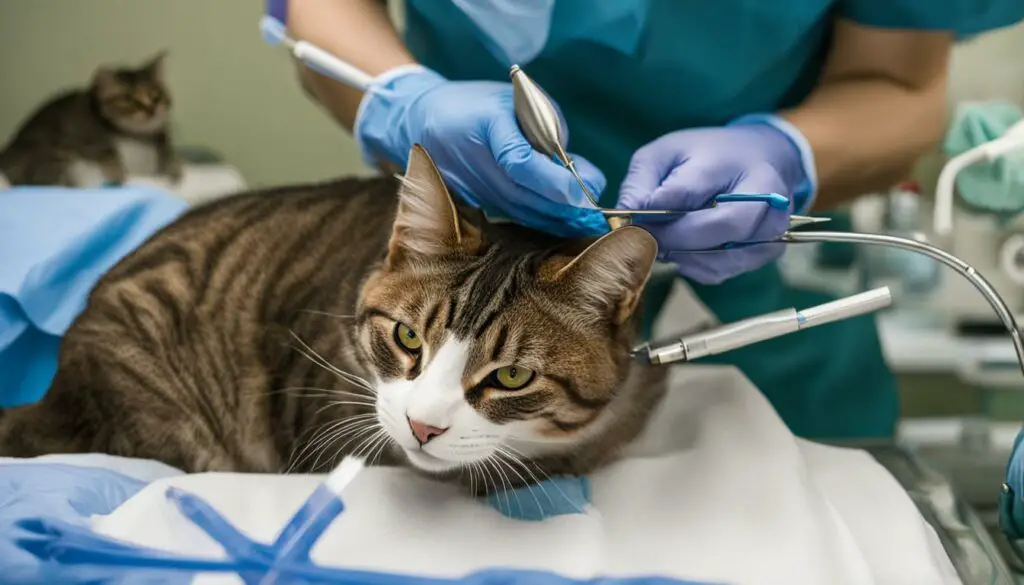
Proper preoperative evaluation and planning are essential in surgical treatment for feline nose diseases. This ensures that the surgical techniques employed are tailored to each cat’s specific condition, minimizing the risk of complications. The success of the surgical intervention relies on the expertise of the veterinary team and their ability to effectively address the underlying issues.
By utilizing surgical techniques, veterinarians can provide targeted treatment for feline nose diseases, helping cats find relief from their symptoms and improve their quality of life.
Complications and Prognosis of Feline Nose Surgery
Like any surgical procedure, feline nose surgery can carry certain risks and complications. However, by ensuring careful preoperative evaluation and planning, these complications can be minimized. The specific surgical technique used and the underlying disease being treated can also influence the likelihood of complications.
Some of the potential complications that can occur after feline nose surgery include:
- Postoperative bleeding
- Infection at the surgical site
- Delayed wound healing
- Scarring or deformity of the nasal passages
- Nasal discharge or congestion
- Persistent or recurrent symptoms
It’s important to note that the occurrence of these complications can vary based on the individual cat and the specific surgical procedure performed. Your veterinarian will discuss these risks with you and take steps to minimize them.
The prognosis for cats undergoing nose surgery depends on several factors, including the specific condition being treated, the stage of the disease at the time of diagnosis, and the success of the surgical intervention. In general, early detection and treatment tend to lead to better outcomes. However, the long-term prognosis can also be influenced by factors such as the presence of underlying health issues and the potential for disease recurrence.
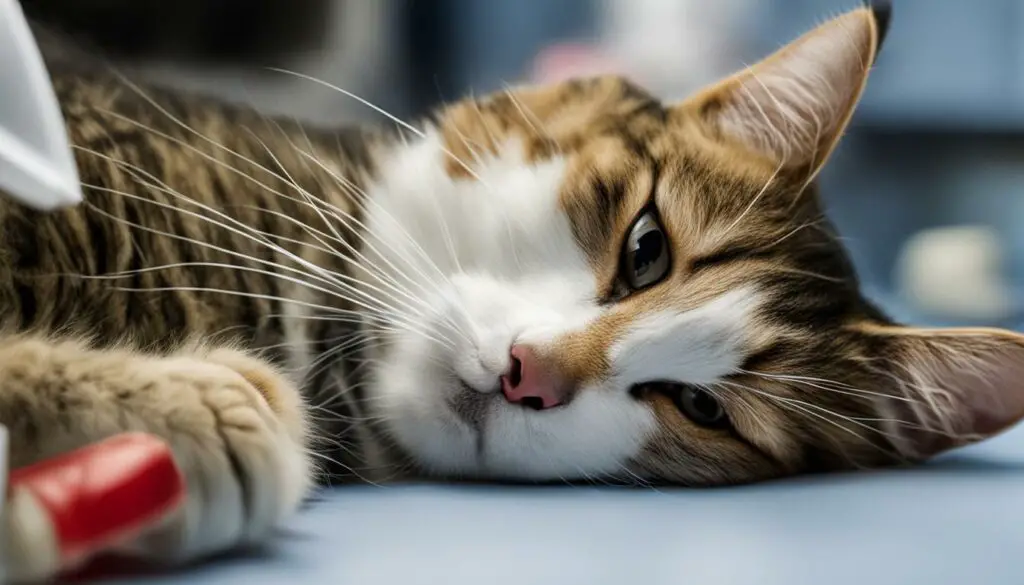
In conclusion, while feline nose surgery can present certain risks, it is an important therapeutic option for cats with nasal diseases. By working closely with your veterinarian and following their recommendations, you can help ensure the best possible outcome for your feline companion.
Conclusion
In conclusion, nose diseases such as nasal polyps and deviated septums can have a significant impact on the health of cats. Early and accurate diagnosis is crucial in order to provide appropriate treatment and relief to affected felines. Surgical techniques, such as the removal of polyps, can be effective in improving the overall well-being of cats with these conditions.
However, it is important to note that the likelihood of recurrence after surgical intervention can vary. Ongoing medical management and close monitoring by a veterinarian may be necessary to ensure the best possible outcome for cats with deviated septums or other nose diseases.
By working closely with a trusted veterinarian and following their recommendations, cat owners can play a crucial role in managing these conditions and maximizing their feline companions’ quality of life. Regular check-ups and prompt reporting of any new symptoms or changes in the cat’s condition can help address any potential issues before they become more severe.
In summary, while nose diseases in cats can present challenges, with proper diagnosis, treatment, and ongoing care, these conditions can be effectively managed, allowing cats to live healthier and happier lives.
FAQ
Can cats have deviated septums?
Yes, cats can have deviated septums, which can cause nasal congestion and other respiratory issues.
What are the symptoms of a deviated septum in cats?
Symptoms of a deviated septum in cats can include sneezing, nasal congestion, and difficulty breathing.
What causes nasal polyps in cats?
The exact cause of nasal polyps in cats is not fully understood, but a genetic predisposition and certain infections may play a role.
How are nasal polyps diagnosed in cats?
Nasal polyps in cats can be diagnosed through careful examination, imaging (such as radiographs or CT scans), rhinoscopy, and cytology or histology of nasal samples.
What is the treatment for nasal polyps in cats?
Surgical removal of nasal polyps is a common treatment approach in cats, along with the use of medications to reduce inflammation and prevent recurrence.
Do nasal polyps in cats recur?
Yes, nasal polyps in cats have a moderate likelihood of recurrence, ranging from 15% to 50% after surgical removal.
What are the common nose diseases in cats?
Common nose diseases in cats include neoplasia, rhinitis, foreign bodies, fungal infections, and polyps.
What are the symptoms of feline nose diseases?
Symptoms of feline nose diseases can include sneezing, nasal discharge, facial swelling, and difficulty breathing.
How are feline nose diseases diagnosed?
Diagnosis of feline nose diseases involves a combination of history-taking, clinical examination, imaging (radiography, CT scans, or MRI), and cytology or histology of nasal samples.
What imaging techniques are used for feline nose diseases?
Radiography, CT scans, and MRI can be used to image the feline nose and aid in the diagnosis of nose diseases.
What is rhinoscopy and how is it used in feline nose diseases?
Rhinoscopy is a diagnostic tool that allows direct visualization of the nasal cavity and the collection of biopsy samples for histopathology in feline nose diseases.
What is the role of cytology, histology, and culture in feline nose diseases?
Cytology, histology, and culture can help in the diagnosis of feline nose diseases and provide important information about the underlying cause.
What surgical techniques are used for feline nose diseases?
Surgical techniques such as biopsies, rhinotomy, and nasal planectomy may be performed to treat feline nose diseases.
What are the complications and prognosis of feline nose surgery?
Complications can occur in feline nose surgery, but they can be minimized through careful preoperative evaluation and planning. The prognosis depends on the specific condition and the success of surgical treatment.
What should I know about cats with deviated septums or other nose diseases?
Early and accurate diagnosis is crucial for appropriate treatment of cats with deviated septums or other nose diseases. Surgical techniques like polyp removal can help improve feline health, but ongoing medical management may be necessary.
Source Links
- https://www.ncbi.nlm.nih.gov/pmc/articles/PMC7418253/
- https://vcahospitals.com/know-your-pet/nasal-polyps-in-cats
- https://www.ncbi.nlm.nih.gov/pmc/articles/PMC7158294/


